Uncover Carcassonne's vibrant flavors and culinary gems with our expert guides. Plan an unforgettable trip now!
Read more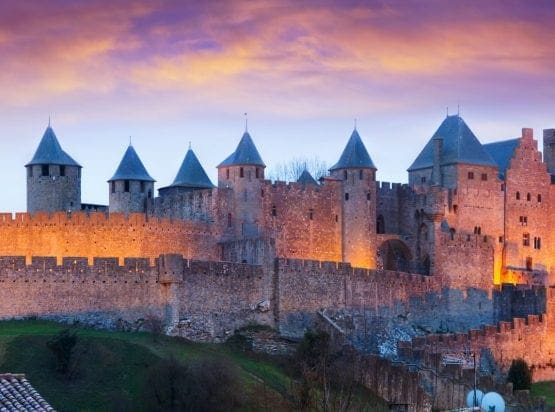
EXPLORE ALL OUR LANGUEDOC-ROUSSILLON WINE REGION GUIDE
Last updated: April 4, 2025
Named after the Greek goddess Minerva, this is one Languedoc vineyard that lives up to the hype. It is a source of delectable and majestic red wines, typically based on a judicious mix of Mourvèdre, Grenache, and Syrah – three totemic grape varieties of the western Mediterranean. In lesser terroirs, these robust grapes can yield overly alcoholic and soupy wine. Yet, they reveal a mosaic of complex, herby flavors on the garrigue-covered slopes of the Montagne Noir. If the Languedoc does possess an unofficial’ First Growth’ appellation, it is undoubtedly Minervois.
Discover More About French Wine
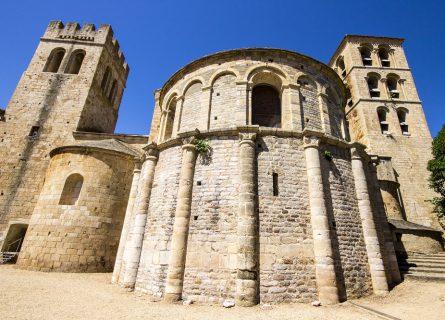
The eastern hills of Carcassonne are prime vineyard real estate, bathed in year-round Mediterranean sunshine. The Phoenicians were among the first ancient civilizations to take advantage of Minervois’ limestone soils and benign climate, followed by the Greeks and Romans. After the Roman invasion of Gaul in the last century BC, the hill on which Carcassonne now stands became an important settlement fortified against incursions from rival powers. Meanwhile, viticulture thrived across the fertile plains and hills of the Bas-Languedoc – the sweet wines of Minervois were praised by both Pliny the Younger and Cicero.
The Dark Ages and Medieval Flourishing
Yet after the collapse of the Western Roman Empire in AD 476, Carcasum, as it was formerly known, became a hotly contested prize in the battle for Western Europe. After several bloody battles, the Visigothic king Theodoric II took control of the city in a major cue for the Germanic invaders. However, the Languedoc was too valuable a commodity for other civilizations to ignore; the Moors successfully ejected the Visigoths from southern France in 725. They were subsequently defeated by the armies of Pépin le Bref, a Frankish king who secured the territory of Occitania (today’s Languedoc) in the 8th century. Ruled by the pragmatic Trencavels, Minervois and its environs became a major wine producer in medieval France, partly used to strengthen the more insipid concoctions of northern France. History also records the vital role that Carcassonne played during the Wars of Religion; the Cathars, a persecuted Christian sect, were given sanctuary here in 1209, but after a two-week siege, the town fell to the Crusaders sent to eradicate them. The French kingdom subsequently absorbed the region.
Decline and Modern-Day Renaissance
However, the Canal du Midi construction in the 1600s saw agriculture flourish in the Languedoc, as barrels of Minervois could be quickly shipped to the city of Toulouse and then to northern France. Unfortunately, the post-phylloxera crisis of the 20th century saw a widespread decline in winemaking quality as growers lazily churned out plonk destined for bulk shipping and blending. Its resurgence occurred after the award of appellation status in 1985, driven by pioneers like Gérard Bertrand.
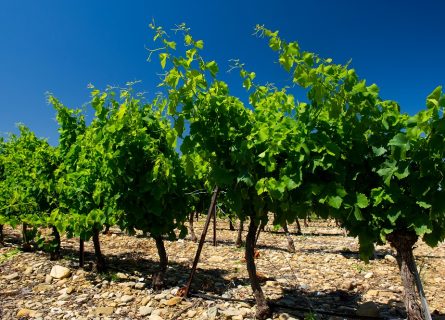
Minervois’ captivating landscape has no equal in the Bas-Languedoc. Centuries of erosion have created a rugged, undulating terrain that invokes the more colorful passages of Tolkien’s Lord of the Rings trilogy! It is beautiful, dramatic, and precarious all at the same time. To find this viticultural paradise, travel northeast from Carcassonne until you reach its western border at Villegailhenc. To the east is Narbonne and its excellent seafood restaurants – Minervois’ northern border is flanked by southern France’s famous Black Mountains (Montagne Noir). It is one of the most significant and most heterogeneous regions in the Languedoc, with a remarkable number of subregions and distinct terroirs. Today, there are approximately 4400 hectares under vine, divided into five subzones: Côtes Noires, La Zone Centrale, and Le Causse. La Clamoux, and La Livinière. Each of these territories has something unique and special to offer.
Diversity of Terroirs
However, many producers covet the Atlantic-influenced mesoclimates of Côtes Noires and La Clamoux due to the cooler temperatures and higher acidity in the wines. Some of the finest red Minervois are made on the alluvial soils (clay, silt, and sand) of La Clamoux – a potent mix of aromatic complexity and bracing freshness. Meanwhile, clinging above the village of Minerve are some of the area’s highest climats (vineyard sites), producing the appellation’s most concentrated and yet balanced expressions of Syrah, Grenache, and Mourvèdre. The free-draining rocky terroir sits atop the limestone bedrock, which retains just the right amount of moisture during the warm and dry summer. To the west is another prodigious subzone: Petit Causse. Its calcareous soils yield a very expressive style of Minervois, renowned for its scent of thyme and lavender. La Zone Centrale refers to the great swathe of vineyards in the appellation’s center. Like the vineyards of Serres, located closest to the Mediterranean, La Zone Centrale is known for its opulence and high alcohol, occasionally exceeding 15%. These are big, blockbuster red wines that can rival the supple tannins and glossy texture of a top Napa Cabernet.
Minervois La Livinière: The Crown Jewel
Nonetheless, all agree that Minervois La Livinière is responsible for the region’s most profound and age-worthy wines. Awarded its own appellation in 1995, La Livinière produces an astonishing amount of exceptional Minervois rouge; it combines the perfume of Petit Causse with the luxury of Serres. Moreover, it boasts a (relative) abundance of old bush vines, with the best often enclosed in a stone wall. An east-facing aspect is preferable here, as it avoids too much afternoon sun, while porous subsoils allow vine roots to dig deep in search of water. The resulting red wines are deeply colored and powerfully structured—every bit a ‘First Growth’ of the Languedoc.
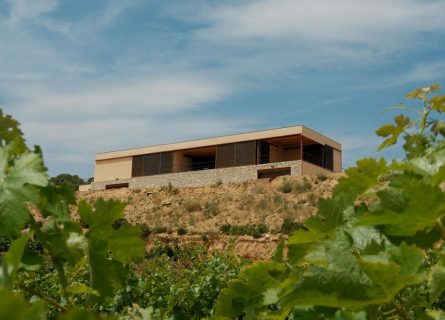
Vignerons in the Languedoc greatly advocate a ‘hands off’ approach to red winemaking. Their general philosophy, refined and adapted over the centuries, suggests that: “the greater the terroir, the fewer human inputs are required.” As a result, Minervois has become a region defined by its vineyards rather than by its enology. Excessive manipulations – cold soak and micro-oxygenation, for example – are seen as wholly undesirable.
The Nuanced Approach to Vinification
Nevertheless, most producers take the winemaking stage very seriously. Their main goal, typically, is to avoid over-extraction and, as a consequence, harsh alcohol and overpowering tannins. This is an ever-present risk in the barmy climate of the Languedoc, particularly in light of climate change. Thus, many estates favor a precise and gentle maceration in steel or concrete tanks, with a relatively brief post-fermentation maceration. In some instances, grape stems may be added to the vat, as ripe stalks bring much-valued freshness and structure to the wine. At Clos d’Ora (owned by Gérard Bertrand), the winemaker includes Carignan stalks in the tank while completely desteeming the Syrah and Mourvèdre. Minervois ‘ top estates routinely practice such a nuanced approach to vinification, where each variety – and terroir – is managed individually. The particular vagaries of the growing season must also be considered – hotter years are always handled with great sensitivity, as harsh tannins and alcohol are a significant risk in such vintages.
The Rising Stars: Minervois Blanc
However, although a great deal of Minervois is red (and increasingly rosé), the quality of local white wines has soared in recent years. Often underpinned by the indigenous Bourboulenc and supported by a varying blend of Macabeo, Grenache Blanc, and some Roussanne/Marsanne, Minervois Blanc can offer exceptional value for money. As ever, cool fermentation in stainless steel and a touch of barrique produce the best results: an attractive mix of ripe fruit, concentration, and freshness.

Minervois has become a strong contender for the Languedoc’s most dynamic and innovative region. Considering the sheer amount of quality wine now being made in Occitanie, that will require some justification.
Visionaries Leading the Way
One of the appellation’s biggest strengths is the chutzpah and vision of its key investors, not least Gérard Bertrand. Indeed, the ex-rugby player turned winemaker has long argued for giving the leading vineyards of the Languedoc the same respect and prestige as the First Growth estates of Pauillac and the venerable Grand Crus of the Cote d’Or. But, unlike certain other producers, Bertrand is willing to put his money where his mouth is. “I remember that in 2019, Emmanuel Macron was hosting a delegation in China; he served two of my luxury red labels alongside a Premier Grand Cru Classé from Bordeaux. This was a defining moment for both me and the wider region – it proved that we were competing as equals,” said Bertrand in 2020. “Nothing is ever permanent – I feel that the quality of wines emerging from this region has helped shift perception on a global scale.”
The Shift to Organic and Biodynamic Practices
Meanwhile, organic and biodynamic viticulture are becoming mainstream in the vineyards of Minervois. This ethos of keeping synthetic inputs to an absolute minimum was once considered the preserve of very wealthy – or wacky – producers who could afford the necessary investment and potential loss of yield; organic growers refrain from using chemical fungicides and pesticides in their vineyards, which can cause problems in difficult vintages. Yet, in the very dry climate of the Bas-Languedoc, organic viticulture is both a cost-effective and hugely beneficial proposition. If you visit the region today, you will notice a healthy population of horses in Minervois – these wonderful animals plow the earth without compacting the soil. They are becoming a must-have accessory in the vineyards of southwest France: eco-friendly and charming to boot.
Innovative Winemaking Techniques
Concrete egg-shaped fermenters are also popping up all over the place, encouraging a more rounded extraction and keeping the lees in gentle circulation in the wine. There is just the right amount of oxygen ingress, too, without any flavor pickup.
The Results in the Glass
All this can be tasted directly and unequivocally in the wines. Today, the best of Minervois (red, white, and rosé) is a beguiling marriage of fruit and finesse – a poster child for the glorious revolution that has enveloped the Languedoc-Roussillon. Before too long, every state banquet, French or otherwise, will have at least one bottle of Minerva’s nectar on the table. Welcome to the club!
Bourboulenc is a white wine grape variety grown mainly in Southern Rhône, Provence, and Languedoc in southern France.
Find out moreGrenache blanc is a white wine grape varietal popular in the Rhône, Châteauneuf-du-Pape and Languedoc-Roussillon regions of Southern France.
Find out moreDiscover Viura: Rioja's Prominent White Grape & Catalonia's Macabeo. Explore its versatility in exquisite wines. A must-read for wine enthusiasts.
Find out moreUncover the allure of Marsanne grape variety. From its traditional role in Rhône blends to the new wave of single-varietal Marsanne wines.
Find out moreLearn about Roussanne, the elegant white grape native to Rhône. Often blended with Marsanne, explore its unique qualities and rich heritage in our guide.
Find out morePicpoul Blanc is a white wine grape varietal grown primarily in the Rhone Valley and Languedoc-Roussillon regions of France.
Find out moreExplore the Renaissance of Sardinian Vermentino: From Forgotten Grape to Crisp Elegance. Discover Now!
Find out moreViognier comes from the northern Rhône valley AOC of Condrieu and is where its most famous white wines are produced.
Find out moreCarignan is a red grape variety that grows mostly in Southern France, and is often used as a blending grape
Find out moreCinsault is a red wine grape that is important in the Languedoc-Roussillon wine region of France because of its tolerance to high temperatures.
Find out moreGarnacha: Spain's Red Gem. Akin to Pinot Noir, it bridges terroir and winemaking, crafting captivating expressions.
Find out moreMourvèdre is a red wine grape variety of mysterious origin that's grown around the world, including the Rhone and Provence regions of France.
Find out moreSyrah is dark-skinned and perhaps the most underrated of the 'noble' red grape varieties.
Find out moreTerret noir is a dark-skinned grape variety from France's Rhône valley and a mutation of the ancient Terret vine. It's allowed in Châteauneuf-du-Pape blends and, like its relatives, Terret gris and Terret blanc, buds late and grows vigorously. The grape yields light-colored, tart, perfumed wines.
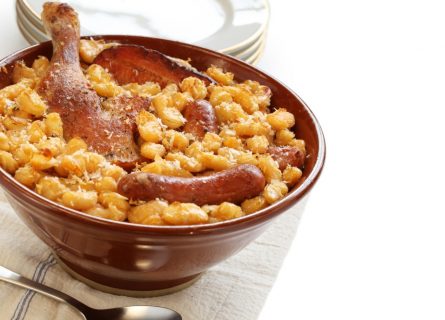
Dining out in Carcassonne’s old quarter (La Cite) is a magical gastronome experience. On a warm summer’s evening, sip the local Blanquette de Limoux before ordering the obligatory cassoulet, a piping hot dish of white beans, diced pork knuckle, and spicy sausage. The confit de canard, as is the roast-sucking pig, is also reliably excellent in Carcassonne. Our best advice is to arrive hungry, very hungry indeed.
A Gastronomic Guide to the Cusine of Languedoc-Roussillon: Read more

Uncover Carcassonne's vibrant flavors and culinary gems with our expert guides. Plan an unforgettable trip now!
Read moreIf you would like us to customize an exclusive luxury tour, contact us and let us know your travel plans. We offer luxury food and wine tours for private groups of a mininium two guests. In addition, all of our private, chauffeured tours are available year-round upon request.

